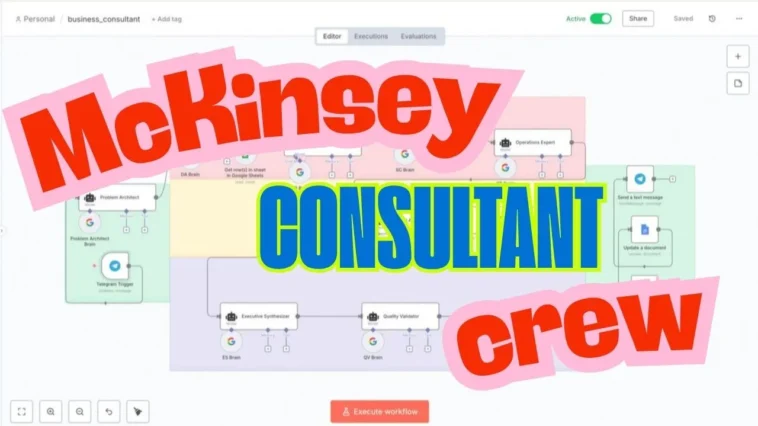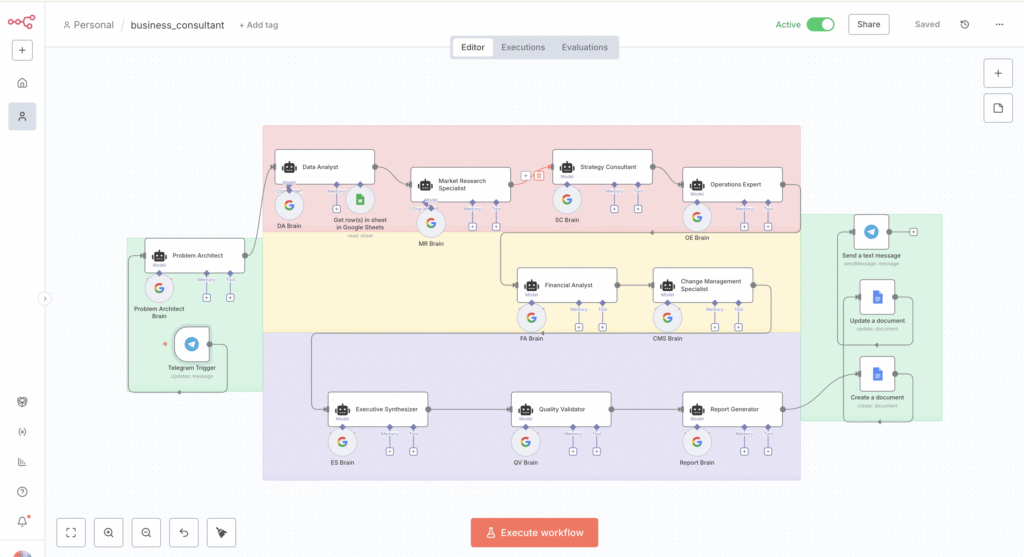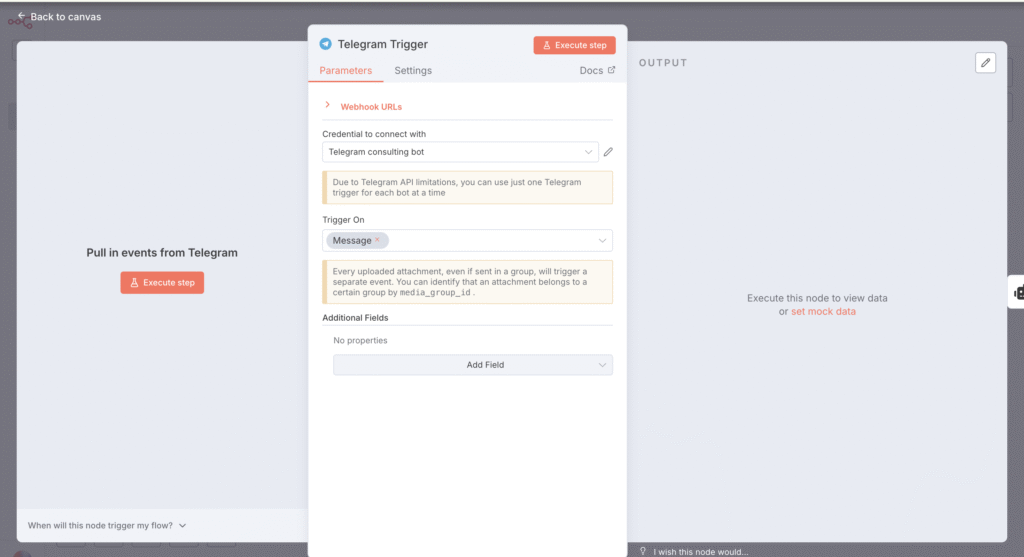McKinsey-Style Consultant Crew Workflow
Crew Structure Overview
Input: Raw problem statement
Output: Multi-specialist analysis with integrated recommendations
8-Member Specialist Crew

1. Problem Architect (Lead)
Role: Structures and defines the problem
Expertise: Problem framing, scope definition, stakeholder analysis
2. Data Analyst
Role: Quantitative analysis and data insights
Expertise: Statistical analysis, trend identification, benchmarking
3. Market Research Specialist
Role: Industry and competitive analysis
Expertise: Market dynamics, competitor intelligence, industry trends
4. Strategy Consultant
Role: Strategic analysis and framework application
Expertise: McKinsey frameworks, strategic options, business model analysis
5. Operations Expert
Role: Process optimization and operational efficiency
Expertise: Process improvement, resource allocation, operational metrics
6. Financial Analyst
Role: Financial modeling and impact assessment
Expertise: ROI analysis, cost-benefit analysis, financial projections
7. Change Management Specialist
Role: Implementation planning and change strategy
Expertise: Organizational change, stakeholder management, communication
8. Executive Synthesizer
Role: Final integration and executive recommendations
Expertise: Executive communication, decision frameworks, action planning
Complete n8n Workflow (12 Nodes)
Node 1: Manual Trigger (I used telegram trigger)
- Input: Raw problem statement
- Output: Problem text for crew analysis

Node 2: Problem Architect (Gemini API)
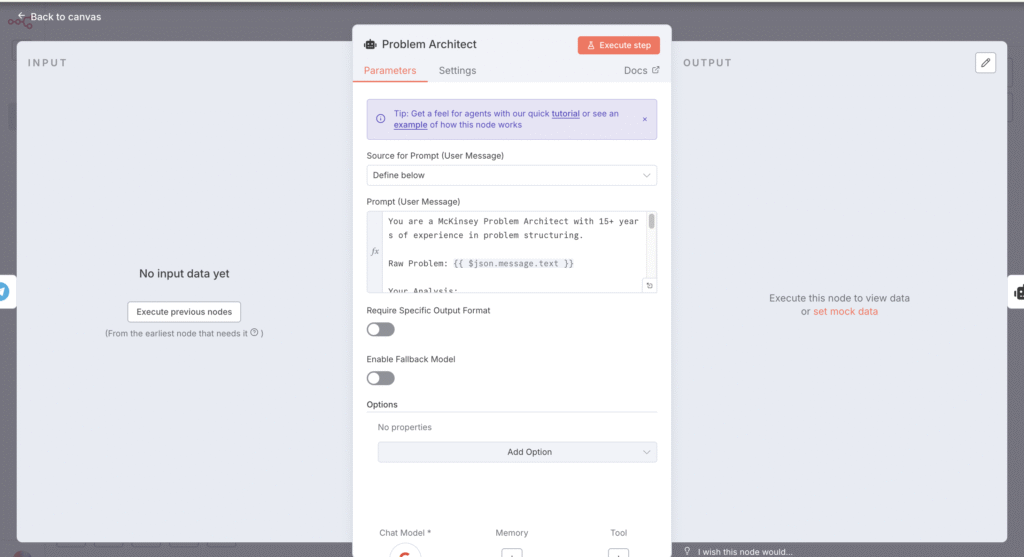
Prompt Template:
You are a McKinsey Problem Architect with 15+ years of experience in problem structuring.
Raw Problem: {{$json.problem}}
Your Analysis:
1. PROBLEM RESTATEMENT (Clear, specific, measurable)
2. HYPOTHESIS TREE (3-4 potential root causes)
3. KEY QUESTIONS (5-7 critical questions to answer)
4. STAKEHOLDER MAP (who's affected and how)
5. SUCCESS CRITERIA (specific, measurable outcomes)
6. SCOPE & BOUNDARIES (what's in/out of scope)
7. URGENCY ASSESSMENT (timeline and criticality)
YOUR RECOMMENDATIONS TO THE CREW:
- What the Data Analyst should focus on
- What the Market Research Specialist should investigate
- Key frameworks for the Strategy Consultant
- Areas for Operations Expert to examine
Format as detailed JSON for crew handoff.Node 3: Data Analyst (Prefer ChatGPT 4.1 API)
Prompt Template:
You are a McKinsey Data Analyst specializing in quantitative analysis.
Problem Architecture: {{$json.problem_architecture}}
Focus Areas: {{$json.data_focus_areas}}
Your Analysis:
1. DATA REQUIREMENTS (what data we need)
2. TREND ANALYSIS (historical patterns and trends)
3. PERFORMANCE METRICS (current vs. target performance)
4. BENCHMARKING (industry standards and best-in-class)
5. CORRELATION ANALYSIS (relationships between variables)
6. STATISTICAL INSIGHTS (key statistical findings)
7. DATA GAPS (missing information we need)
YOUR RECOMMENDATIONS:
- Specific metrics to track
- Data collection strategies
- Performance improvement targets
- Key performance indicators (KPIs)
Provide confidence levels for each finding (High/Medium/Low).Node 4: Market Research Specialist (Perplexity API)
Prompt Template:
You are a McKinsey Market Research Specialist with deep industry expertise.
Problem Context: {{$json.problem_architecture}}
Data Insights: {{$json.data_analysis}}
Your Analysis:
1. MARKET LANDSCAPE (size, growth, key players)
2. COMPETITIVE ANALYSIS (competitor strengths/weaknesses)
3. INDUSTRY TRENDS (macro trends affecting the problem)
4. CUSTOMER INSIGHTS (customer behavior and preferences)
5. REGULATORY ENVIRONMENT (relevant regulations/compliance)
6. TECHNOLOGY IMPACT (tech trends and disruptions)
7. BEST PRACTICES (how industry leaders handle this)
YOUR RECOMMENDATIONS:
- Market positioning strategies
- Competitive response options
- Industry benchmark targets
- Market opportunity assessment
Include specific examples and case studies where relevant.Node 5: Strategy Consultant (Claude API)
Prompt Template:
You are a McKinsey Strategy Consultant specializing in strategic frameworks.
Problem Architecture: {{$json.problem_architecture}}
Data Analysis: {{$json.data_analysis}}
Market Research: {{$json.market_research}}
Your Analysis using McKinsey Frameworks:
1. ISSUE TREE (structured breakdown of the problem)
2. SWOT ANALYSIS (strengths, weaknesses, opportunities, threats)
3. PORTER'S FIVE FORCES (competitive dynamics)
4. VALUE CHAIN ANALYSIS (where value is created/lost)
5. STRATEGIC OPTIONS (3-4 strategic alternatives)
6. OPTION EVALUATION (pros/cons of each option)
7. STRATEGIC RECOMMENDATION (preferred strategic direction)
YOUR RECOMMENDATIONS:
- Strategic priorities (top 3)
- Competitive positioning
- Value creation opportunities
- Strategic implementation sequence
Apply MECE principle and pyramid thinking to all analysis.Node 6: Operations Expert (Claude API)
Prompt Template:
You are a McKinsey Operations Expert specializing in process optimization.
Problem Context: {{$json.problem_architecture}}
Strategic Direction: {{$json.strategic_analysis}}
Your Analysis:
1. PROCESS MAPPING (current state processes)
2. EFFICIENCY ANALYSIS (bottlenecks and inefficiencies)
3. RESOURCE ALLOCATION (current vs. optimal resource use)
4. CAPABILITY ASSESSMENT (organizational capabilities)
5. OPERATIONAL METRICS (key operational indicators)
6. IMPROVEMENT OPPORTUNITIES (specific optimization areas)
7. IMPLEMENTATION COMPLEXITY (ease of implementation)
YOUR RECOMMENDATIONS:
- Process improvement priorities
- Resource reallocation strategies
- Operational efficiency targets
- Implementation roadmap (quick wins to long-term)
Focus on practical, implementable solutions with clear timelines.Node 7: Financial Analyst (Claude API)
Prompt Template:
You are a McKinsey Financial Analyst specializing in business case development.
Problem Context: {{$json.problem_architecture}}
Strategic Options: {{$json.strategic_analysis}}
Operations Plan: {{$json.operations_analysis}}
Your Analysis:
1. FINANCIAL IMPACT ASSESSMENT (current financial impact)
2. COST-BENEFIT ANALYSIS (costs vs. benefits of solutions)
3. ROI PROJECTIONS (expected returns on investment)
4. CASH FLOW IMPACT (short and long-term cash flow)
5. RISK ASSESSMENT (financial risks and mitigation)
6. INVESTMENT REQUIREMENTS (capital and operational costs)
7. PAYBACK PERIOD (time to recover investment)
YOUR RECOMMENDATIONS:
- Financial priorities (highest ROI initiatives)
- Investment sequencing
- Budget allocation recommendations
- Financial success metrics
Provide 3-year financial projections with sensitivity analysis.Node 8: Change Management Specialist (Gemini API)
Prompt Template:
You are a McKinsey Change Management Specialist with expertise in organizational transformation.
Problem Context: {{$json.problem_architecture}}
Strategic Plan: {{$json.strategic_analysis}}
Operations Plan: {{$json.operations_analysis}}
Financial Plan: {{$json.financial_analysis}}
Your Analysis:
1. CHANGE READINESS ASSESSMENT (organization's readiness for change)
2. STAKEHOLDER ANALYSIS (influence and impact mapping)
3. RESISTANCE POINTS (potential sources of resistance)
4. COMMUNICATION STRATEGY (key messages and channels)
5. TRAINING REQUIREMENTS (skills and capability building)
6. IMPLEMENTATION PHASES (change rollout sequence)
7. SUCCESS FACTORS (critical success factors)
YOUR RECOMMENDATIONS:
- Change management priorities
- Stakeholder engagement strategy
- Communication plan
- Training and development needs
- Risk mitigation for change resistance
Focus on practical change management tactics and timelines.Node 9: Executive Synthesizer (Gemini API)
Prompt Template:
You are a McKinsey Senior Partner synthesizing the complete crew analysis.
CREW ANALYSES:
- Problem Architecture: {{$json.problem_architecture}}
- Data Analysis: {{$json.data_analysis}}
- Market Research: {{$json.market_research}}
- Strategy Consulting: {{$json.strategic_analysis}}
- Operations: {{$json.operations_analysis}}
- Financial Analysis: {{$json.financial_analysis}}
- Change Management: {{$json.change_analysis}}
Create INTEGRATED EXECUTIVE RECOMMENDATIONS:
1. EXECUTIVE SUMMARY (3-sentence problem and solution overview)
2. KEY INSIGHTS (top 5 insights from all analyses)
3. STRATEGIC RECOMMENDATIONS (3 main recommendations with rationale)
4. IMPLEMENTATION ROADMAP:
- Quick Wins (0-90 days)
- Medium-term (3-6 months)
- Long-term (6-12 months)
5. RESOURCE REQUIREMENTS (people, budget, technology)
6. SUCCESS METRICS (how to measure progress)
7. RISK MITIGATION (top 3 risks and mitigation strategies)
8. NEXT STEPS (immediate actions for next 30 days)
Format as executive-ready presentation with clear action items.Node 10: Quality Validator (Gemini API)
Prompt Template:
You are a McKinsey Quality Assurance Partner reviewing the crew's work.
COMPLETE ANALYSIS: {{$json.executive_synthesis}}
Validate:
1. LOGIC CONSISTENCY (are recommendations logical and consistent?)
2. COMPLETENESS (are all aspects covered adequately?)
3. FEASIBILITY (are recommendations realistic and implementable?)
4. MEASURABILITY (are success metrics clear and trackable?)
5. RISK COVERAGE (are major risks identified and addressed?)
Provide:
- QUALITY SCORE (1-10)
- STRENGTHS (what was done well)
- GAPS (what needs improvement)
- FINAL RECOMMENDATIONS (any adjustments needed)
Only approve if quality score is 8+ or provide specific improvement areas.Node 11: Report Generator (Gemini API)
Prompt Template:
Create a comprehensive McKinsey-style executive report:
VALIDATED ANALYSIS: {{$json.validated_analysis}}
Format as professional consulting report:
# EXECUTIVE BRIEF: [Problem Title]
## SITUATION
[2-3 sentences describing the problem]
## KEY FINDINGS
- [Finding 1 with supporting data]
- [Finding 2 with supporting data]
- [Finding 3 with supporting data]
## RECOMMENDATIONS
### 1. [Recommendation 1]
- Rationale: [Why this is important]
- Impact: [Expected outcome]
- Timeline: [Implementation period]
### 2. [Recommendation 2]
- Rationale: [Why this is important]
- Impact: [Expected outcome]
- Timeline: [Implementation period]
### 3. [Recommendation 3]
- Rationale: [Why this is important]
- Impact: [Expected outcome]
- Timeline: [Implementation period]
## IMPLEMENTATION ROADMAP
**Next 30 Days**: [Immediate actions]
**Next 90 Days**: [Quick wins]
**Next 6 Months**: [Medium-term goals]
**Next 12 Months**: [Long-term objectives]
## EXPECTED IMPACT
- Financial: [Quantified financial impact]
- Operational: [Operational improvements]
- Strategic: [Strategic advantages]
## RISKS & MITIGATION
1. **Risk**: [Risk description] | **Mitigation**: [How to address]
2. **Risk**: [Risk description] | **Mitigation**: [How to address]
3. **Risk**: [Risk description] | **Mitigation**: [How to address]
Keep report under 1000 words, executive-ready.Node 12: Docs/Notion Integration
Purpose: Save complete analysis to Notion database
Data Structure: All specialist analyses + final report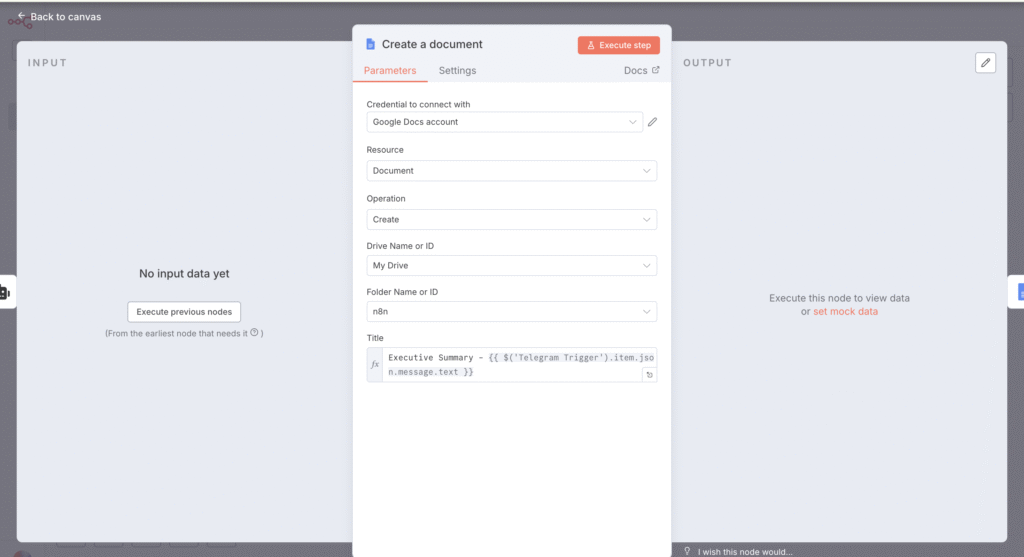
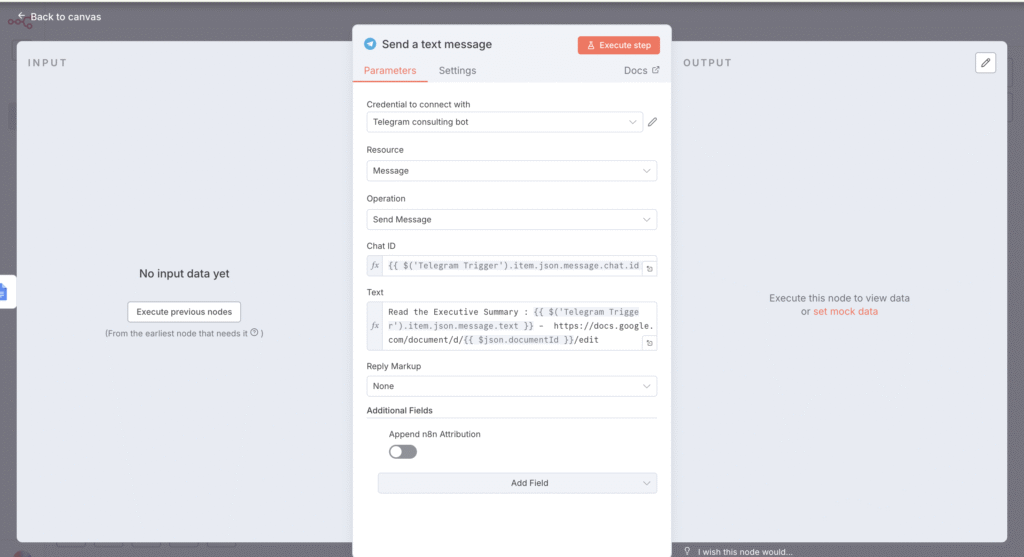
Specialist Handoff Structure
Each specialist builds upon previous work:
Problem Architect → Defines structure for all specialists Data Analyst → Uses architecture to focus analysis Market Research → Incorporates data insights Strategy Consultant → Builds on market and data analysis Operations Expert → Implements strategic direction Financial Analyst → Quantifies operational and strategic plans Change Management → Enables implementation of all plans Executive Synthesizer → Integrates all specialist recommendations
Download the full n8n workflow here


